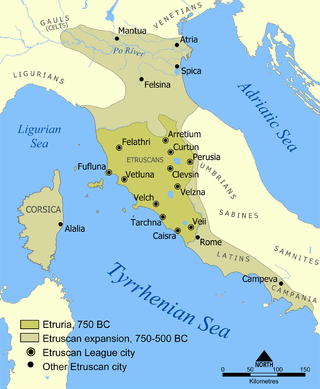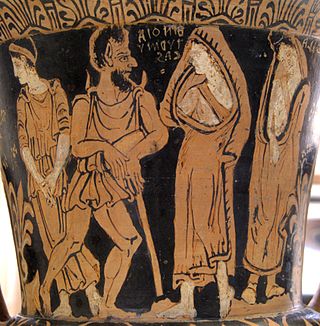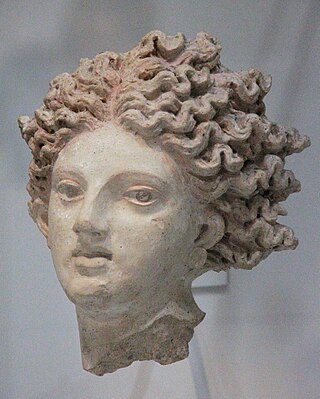
The Etruscan civilization was an ancient civilization created by the Etruscans, a people who inhabited Etruria in ancient Italy, with a common language and culture who formed a federation of city-states. After conquering adjacent lands, its territory covered, at its greatest extent, roughly what is now Tuscany, western Umbria, and northern Lazio, as well as what are now the Po Valley, Emilia-Romagna, south-eastern Lombardy, southern Veneto, and western Campania.

Etruscan religion comprises a set of stories, beliefs, and religious practices of the Etruscan civilization, heavily influenced by the mythology of ancient Greece, and sharing similarities with concurrent Roman mythology and religion. As the Etruscan civilization was gradually assimilated into the Roman Republic from the 4th century BC, the Etruscan religion and mythology were partially incorporated into ancient Roman culture, following the Roman tendency to absorb some of the local gods and customs of conquered lands. The first attestations of an Etruscan religion can be traced back to the Villanovan culture.

Aita, also spelled Eita, is an epithet of the Etruscan chthonic fire god Śuri as god of the underworld, roughly equivalent to the Greek god Hades.

In Etruscan mythology, Charun acted as one of the psychopompoi of the underworld. He is often portrayed with Vanth, a winged figure also associated with the underworld.
In Etruscan religion, Fufluns or Puphluns was a god of plant life, happiness, wine, health, and growth in all things. He is mentioned twice among the gods listed in the inscriptions of the Liver of Piacenza, being listed among the 16 gods that rule the Etruscan astrological houses. He is the 9th of those 16 gods. He is the son of Semla and the god Tinia. He was worshipped at Populonia and is the namesake of that town.

Menrva was an Etruscan goddess of war, art, wisdom, and medicine. She contributed much of her character to the Roman Minerva. She was the child of Uni and Tinia.

In Etruscan religion and mythology, Thesan is the Etruscan goddess of the dawn. Thesan is the Roman equivalent of Aurora. In Etruria, she received offerings together with the sun god Usil as described in the liber linteus. She was especially worshipped at Caere's harbour of Pyrgi, where a temple was dedicated to her and a singular series of "daybreak antefixes" was excavated.

Turan was the Etruscan goddess of love, fertility and vitality and patroness of the city of Velch.

The Apollo of Veii is a life-size painted terracotta Etruscan statue of Aplu (Apollo), designed to be placed at the highest part of a temple. The statue was discovered in the Portonaccio sanctuary of ancient Veii, Latium, in what is now central Italy, and dates from c. 510-500 BC. It was created in the so-called "international" Ionic or late-archaic Etruscan style.

Usil is the Etruscan god of the sun, shown to be identified with Apulu (Apollo). His iconic depiction features Usil rising out of the sea, with a fireball in either outstretched hand, on an engraved Etruscan bronze mirror in late Archaic style, formerly on the Roman antiquities market. On Etruscan mirrors in the Classical style, Usil appears with an aureole.

The Tomb of Orcus, sometimes called the Tomb of Murina, is a 4th-century BC Etruscan hypogeum in Tarquinia, Italy. Discovered in 1868, it displays Hellenistic influences in its remarkable murals, which include the portrait of Velia Velcha, an Etruscan noblewoman, and the only known pictorial representation of the daemon Tuchulcha. In general, the murals are noted for their depiction of death, evil, and unhappiness.

Satre or Satres was an Etruscan god who appears on the Liver of Piacenza, a bronze model used for haruspicy. He occupies the dark and negative northwest region, and seems to be a "frightening and dangerous god who hurls his lightning from his abode deep in the earth." It is possible that Satre is also referred to with the word "satrs" in the Liber Linteus, the Etruscan text preserved in Ptolemaic Egypt as mummy wrappings.
Cel was the Etruscan goddess of the earth. On the Etruscan calendar, the month of Celi (September) is likely named for her. Her Greek counterpart is Gaia and her Roman is Tellus.

Catha is a female Etruscan lunar or solar deity, who may also be connected to childbirth, and has a connection to the underworld. Catha is also the goddess of the south sanctuary at Pyrgi, Italy.
Leinth is an Etruscan deity. Within Etruscan iconography, it is difficult to distinguish mortals from divine figures without inscriptions. Inscriptions to the god Leinth have only been identified on two bronze mirrors and a single fragment of ceramic, found within an artisan’s zone on an Etruscan site in Italy. It is difficult, with such little evidence, to determine what may seem to be even the most rudimentary qualities of the deity, because the Etruscans did not consistently assign specific genders or attributes to their gods. Leinth appears both as a male and a female on two different bronze mirrors, and aside from the inscription, there seem to be no distinguishing traits to connect the figures.

Culsans (Culśanś) is an Etruscan deity, known from four inscriptions and a variety of iconographical material which includes coins, statuettes, and a sarcophagus. Culśanś is usually rendered as a male deity with two faces and at least two statuettes depicting him have been found in close association with city gates. These characteristics suggest that he was a protector of gateways, who could watch over the gate with two pairs of eyes.

Apulu, also syncopated as Aplu, is an epithet of the Etruscan fire god Śuri as chthonic sky god, roughly equivalent to the Greco-Roman god Apollo. Their names are associated on Pyrgi inscriptions too. The name Apulu or Aplu did not come directly from Greece but via a Latin center, probably Palestrina.
Śuri, Latinized as Soranus, was an ancient Etruscan infernal, volcanic and solar fire god, also venerated by other Italic peoples – among them Capenates, Faliscans, Latins and Sabines – and later adopted into ancient Roman religion.














